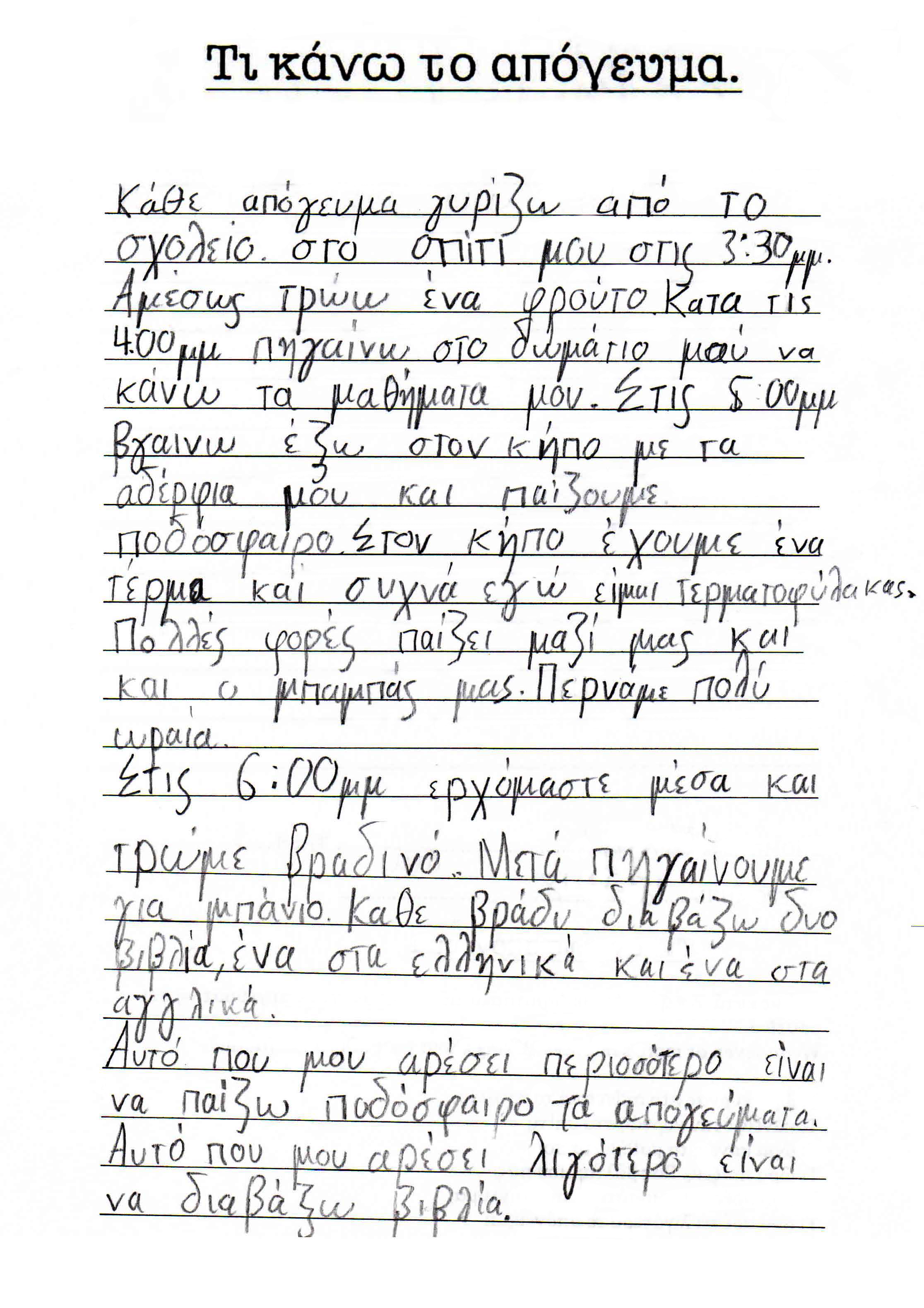- Home
- Resources
- Work samples
- Samples
- Τι κάνω το απόγευμα – AT
Languages: Modern Greek
Years 7 and 8 (Year 7 entry)
Satisfactory
Τι κάνω το απόγευμα
Summary of task
Students learnt personal and school routines for various parts of the day. In this task students wrote sentences and paragraphs in relation to the sequence of their afternoon routine, using a range of language features and functions and appropriate punctuation to describe activities and express feelings.
Achievement standard
By the end of Year 8, students use Greek to describe feelings (for example, Αγαπώ τη μουσική), express likes and dislikes (for example, Δε μου αρέσει η σοκολάτα) and exchange information about their personal worlds, including information about themselves (for example, Mε λένε Γιώργο, Mένω στην Αυστραλία), their family (for example, O πατέρας μου είναι ψηλός), friends (for example, Ο Γιάννης είναι φίλος μου) and interests such as, Μου αρέσει η μπάλα. They interact with others in collaborative and classroom activities, using modelled language to carry out transactions (for example, Τι ώρα θα πάμε κυρία; Πόσο κάνουν οι καφέδες;), ask and respond to familiar questions such as, Το τρένο φεύγει στις δέκα; follow instructions, and seek help or permission (for example, Μπορώ να πάω σινεμά; Η τράπεζα είναι στο δεύτερο δρόμο δεξιά, Συγγνώμη κύριε αλλάδεν καταλαβαίνω). When interacting, students pronounce Greek sounds, and use intonation and accentuation such as, Το σχολείο, ο φίλος, οι φίλοι, Η Ελένη αγόρασε καινούρια μπλούζα. They obtain information and identify key points from different sources, using non-verbal and contextual clues to help make meaning. Students describe characters, events and ideas in imaginative texts using high-frequency vocabulary and create short informative and imaginative texts using modelled sentence structures and formulaic expressions (for example, Γεια σου μαμά / Καλημέρακυρία Σοφία, Πώς είστε; χαιρετισμούς, Με αγάπη). They use the present tense (for example, Μένωστην Αυστραλία), common verbs (for example, γράφω, διαβάζω, θέλω, είμαι, έχω) and other grammatical structures such as verb endings (for example, ω, εις, ει, ουμε, ετε, ουν) and singular and plural forms (for example, ο, οι, η, οι, το, τα) to create simple sentences and phrases such as, Τί κάνεις σήμερα; They translate and interpret texts using contextual clues and textual features and create simple bilingual texts for classroom use. When interacting, students modify their language and behaviour and recognise that aspects of their own language and culture impact on intercultural exchange (for example, Το Πάσχα βάφουμε κόκκινα αυγά).
Students identify the similarities and differences between the sound systems of Greek and English (for example, γγ, μπρ, τσ, γκ, ντρ, ντ, γ, ζ, υ, ξ, ψ, χ, μυθολογία, ιστορία, οξυγόνο, χιλιόμετρο). They describe the key features of common types of texts, comparing them with equivalent text types in English. They give examples of how language varies according to participants, roles and relationships, and context and culture (for example, η μαμά, η μητέρα). They identify ways that Greek language and culture have influenced and continue to influence many global languages. They analyse words and expressions to identify and explain connections between language and culture such as, Στην υγεία σου/σας, Με γεια, Γεια στα χέρια σου/σας.
 1
Annotation 1
1
Annotation 1
Uses present tense verb to share information about daily activities 2 Annotation 2
Uses prepositions of place 3 Annotation 3
Uses adverbs to sequence events 4 Annotation 4
Recognises the use of singular and plural forms in same sentence 5 Annotation 5
Applies appropriate accentuation 6 Annotation 6
Describes feelings 7 Annotation 7
Punctuates sentences uses capital letters, commas and full-stop 8 Annotation 8
Expresses likes and preferences
-
Annotations
-
1
Annotation 1
Uses present tense verb to share information about daily activities -
2
Annotation 2
Uses prepositions of place -
3
Annotation 3
Uses adverbs to sequence events -
4
Annotation 4
Recognises the use of singular and plural forms in same sentence -
5
Annotation 5
Applies appropriate accentuation -
6
Annotation 6
Describes feelings -
7
Annotation 7
Punctuates sentences uses capital letters, commas and full-stop -
8
Annotation 8
Expresses likes and preferences
